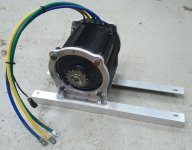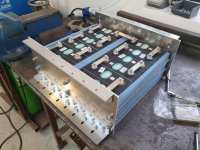Lorax_UK
1 mW
I am mid way into converting a Polaris Ranger (400 Petrol) to EV.
The plan is/was to use a QS180 motor and Fardriver 96850 controller, which I have already purchased. I got these at a good price.
The problem is that I was hoping to use a 48V battery pack, which I've designed to be modular, so I can use it for a number of different applications. But I see in the controller spec, that it's rated for a nominal battery voltage of 60-96v.
The battery I've built is just over 300Ah, and so at 1C can discharge at 300 Amps. I guess this gives me about 15kW? The motor is rated at 8kW continuous, and 15kW peak, though probably not at an under-rated 48V.
So the ideas I'm considering, are:
1- Just try the controller with 48V and see what happens
2- Buy a similar controller that's rated to run with 48V
(presumably this means I'll not be getting max performance from the QS180 motor, but this probably isn't a huge deal for me)
3- Build a battery specifically for this application, using NMC prismatic cells, about 120Ah, 96V
Do you have any advice? Thanks in advance
The plan is/was to use a QS180 motor and Fardriver 96850 controller, which I have already purchased. I got these at a good price.
The problem is that I was hoping to use a 48V battery pack, which I've designed to be modular, so I can use it for a number of different applications. But I see in the controller spec, that it's rated for a nominal battery voltage of 60-96v.
The battery I've built is just over 300Ah, and so at 1C can discharge at 300 Amps. I guess this gives me about 15kW? The motor is rated at 8kW continuous, and 15kW peak, though probably not at an under-rated 48V.
So the ideas I'm considering, are:
1- Just try the controller with 48V and see what happens
2- Buy a similar controller that's rated to run with 48V
(presumably this means I'll not be getting max performance from the QS180 motor, but this probably isn't a huge deal for me)
3- Build a battery specifically for this application, using NMC prismatic cells, about 120Ah, 96V
Do you have any advice? Thanks in advance




